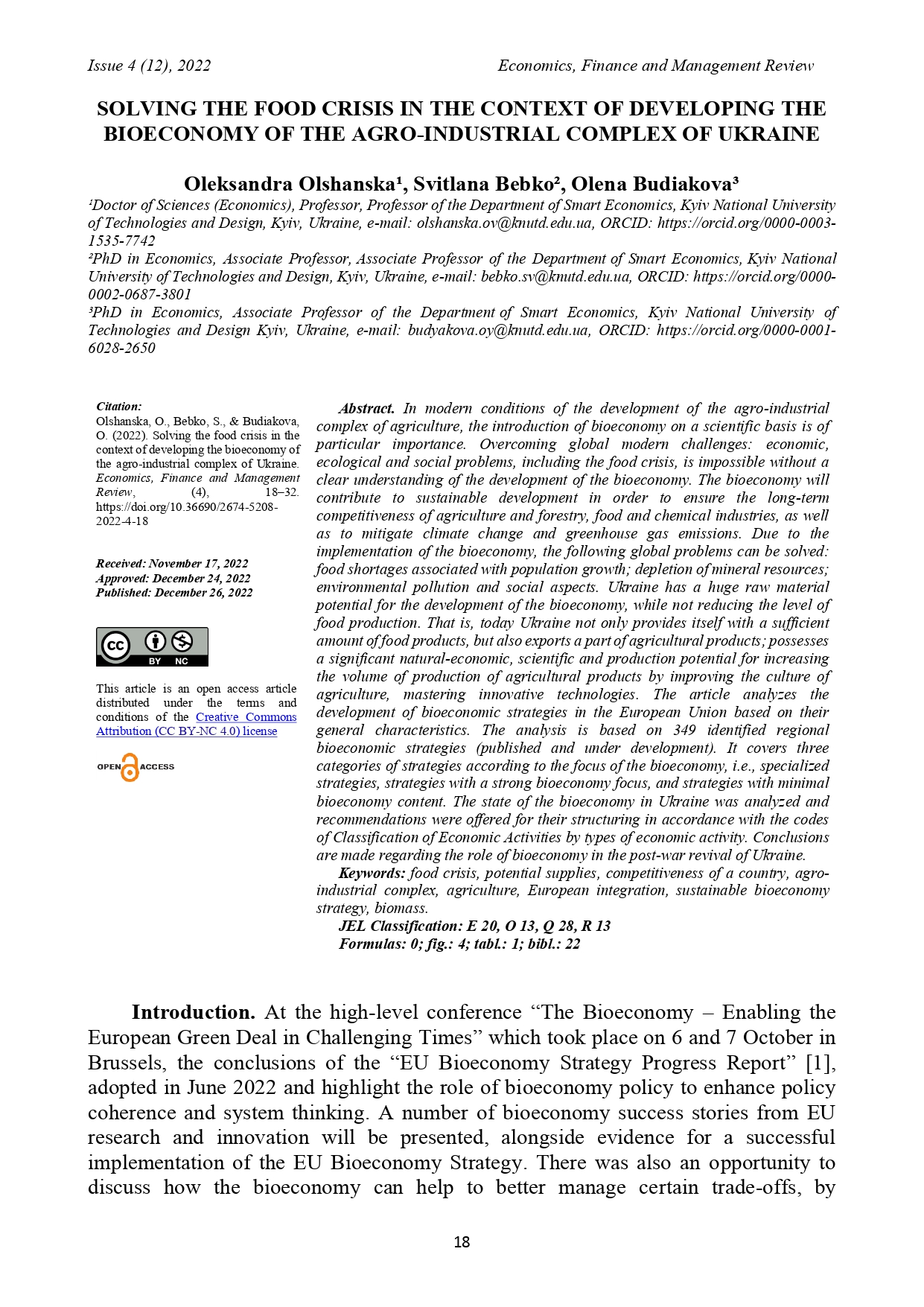SOLVING THE FOOD CRISIS IN THE CONTEXT OF DEVELOPING THE BIOECONOMY OF THE AGRO-INDUSTRIAL COMPLEX OF UKRAINE
DOI:
https://doi.org/10.36690/2674-5208-2022-4-18Keywords:
food crisis, potential supplies, competitiveness of a country, agro-industrial complex, agriculture, European integration, sustainable bioeconomy strategy, biomassAbstract
In modern conditions of the development of the agro-industrial complex of agriculture, the introduction of bioeconomy on a scientific basis is of particular importance. Overcoming global modern challenges: economic, ecological and social problems, including the food crisis, is impossible without a clear understanding of the development of the bioeconomy. The bioeconomy will contribute to sustainable development in order to ensure the long-term competitiveness of agriculture and forestry, food and chemical industries, as well as to mitigate climate change and greenhouse gas emissions. Due to the implementation of the bioeconomy, the following global problems can be solved: food shortages associated with population growth; depletion of mineral resources; environmental pollution and social aspects. Ukraine has a huge raw material potential for the development of the bioeconomy, while not reducing the level of food production. That is, today Ukraine not only provides itself with a sufficient amount of food products, but also exports a part of agricultural products; possesses a significant natural-economic, scientific and production potential for increasing the volume of production of agricultural products by improving the culture of agriculture, mastering innovative technologies. The article analyzes the development of bioeconomic strategies in the European Union based on their general characteristics. The analysis is based on 349 identified regional bioeconomic strategies (published and under development). It covers three categories of strategies according to the focus of the bioeconomy, i.e., specialized strategies, strategies with a strong bioeconomy focus, and strategies with minimal bioeconomy content. The state of the bioeconomy in Ukraine was analyzed and recommendations were offered for their structuring in accordance with the codes of Classification of Economic Activities by types of economic activity. Conclusions are made regarding the role of bioeconomy in the post-war revival of Ukraine.
Downloads
References
European Commission, Directorate-General for Research and Innovation, (2022). European bioeconomy policy : stocktaking and future developments : report from the Commission to the European Parliament, the Council, the European Economic and Social Committee and the Committee of the Regions, Publications Office of the European Union. Retrieved from https://data.europa.eu/doi/10.2777/997651
The Global Food System: An Analysis. Retrieved from http://surl.li/eerll
Global Food Policy Report 2022: Climate Change & Food Systems. Retrieved from http://surl.li/eerlp
Gonta, D., Kyrylyuk, E., Proshchalykina, A., Ryzhenko, N. (2020). Formation of the components of the national bioeconomy of Ukraine in conditions of acceleration of scientific and technological progress: monograph. Cherkasy: CHNU named after B. Khmelnytskyi.
Oleshko, A., Olshanska, O., Budіakova, O. and Bebko, S. (2022). Development of sustainable bioeconomy: the experience of the European Union and opportunities for Ukraine. Agrosvit, 3, 64-69. doi: 10.32702/2306-6792.2022.3.64
European Commission, Joint Research Centre, Haarich, S., Kirchmayr-Novak, S., Bioeconomy strategy development in EU regions, Borzacchiello, M.(editor), Sanchez Lopez, J.(editor), Avraamides, M.(editor), Publications Office of the European Union, 2022. Retrieved from https://data.europa.eu/doi/10.2760/065902
European Commission (2018). A sustainable bioeconomy for Europe: strengthening the connection between economy, society and the environment. Updated Bioeconomy Strategy. doi: 10.2777/478385.
Yasnolob, I.O., Demyanenko, N.V., Chernenko, K.V. (2021). Conceptual principles of bioeconomy strategy. Market infrastructure,54, 74-77.
Talavirya, M., Gazuda, L., Gazuda, M. (2021). Prospects for the development of closed cycle bioeconomy in Ukraine. Geopolitics of Ukraine: history and modernity, 2 (27), 128-138.
Intellectualization of the socio-economic development of Ukraine in the perspective of post-war recovery: monograph (2022). / for the science. ed. O. V. Olshanska, A. A. Oleshko, Z. Ya. Shatska. Kyiv: KNUTD. doi: 10.30857/978.617.7763.05.4
State Statistics Service of Ukraine (2010), "National classifier of Ukraine. Classification of economic activities (CTEA) DK 009:2010"Retrieved from http://registral.kiev.ua/kved
Retrieved from https://elevatorist.com/blog/read/671-kurs-ukrainyi-na-bioekonomiku
Baidala, V.V. (2016). Bioeconomy in Ukraine: formation, development prospects and macroeconomic influences: [monograph]. Sumy.
Baidala, V.V., Butenko, V.M. (2014). Investments in the bioeconomy as a factor in the sustainable development of the agricultural sector of Ukraine. The main priorities of the development of the agro-industrial complex of Ukraine in the context of economic, food and energy security of the country: a monograph / Ed. Doctor of Economics, Professor Yu.O. Nesterchuk. Uman: Publishing and Printing Center "Vizavy" (Publisher "Sochinsky").
Baidala, V.V. Butenko, V.M. (2015). Methodical approaches to assessing the potential of the bioeconomy in Ukraine. Business information, 4, 29-34.
Shubravska, O. (2010). Bioeconomy: analysis of global development and prerequisites for development in the agrarian sector of the economy of Ukraine. Economy of Ukraine, 10, 63-73.
Innovative transformations of the agrarian sector of the economy: a monograph (2012). / [Shubravska O. V. and others]; under the editorship Dr. Econ. Sciences Shubravska O. V.; National Acad. of Sciences of Ukraine, State University "Institute of Economics and Forecasting of the National Academy of Sciences of Ukraine".
Litvak, O.A. (2015). Bioeconomic approach in the development of the agrarian sector of the economy: theoretical, methodological and practical aspects. Mykolaiv National Agrarian University. Mykolaiv: MNAU.
Litvak, O.A. (2015). Bioeconomic priorities in the development of the agricultural sector. Hlobalni ta natsionalni problemy ekonomiky, 8. Retrieved from: http://global-national.in.ua/issue-8-2015
Concept of the State Strategy for the Development of Ukraine's Bioeconomy until 2030 Retrieved from: https://nubip.edu.ua/node/72005
The World Bank Group (2022). Protecting the most vulnerable must be foremost in addressing economic fallout of war in Ukraine. Retrieved from: https://www.worldbank.- org/en/topic/conflict/brief/the-w
Oleshko, A., Budiakova, O. and Kvas, V. (2022). Regulatory role of the state in the recovery of the national economy. Ekonomika ta derzhava, 8, 4-13. doi: 10.32702/2306-6806.2022.8.15
Oleshko, A., Olshanska, O., Budiakova, O. and Bebko, S. (2022). Directions of bioeconomy development in the perspective of postwar recovery of Ukraine. Problems of innovation and investment development. "Economics and Management" series, 18-28. doi:10.33813/2224-1213.28.2022.2

Downloads
Published
How to Cite
Issue
Section
License

This work is licensed under a Creative Commons Attribution-NonCommercial 4.0 International License.








